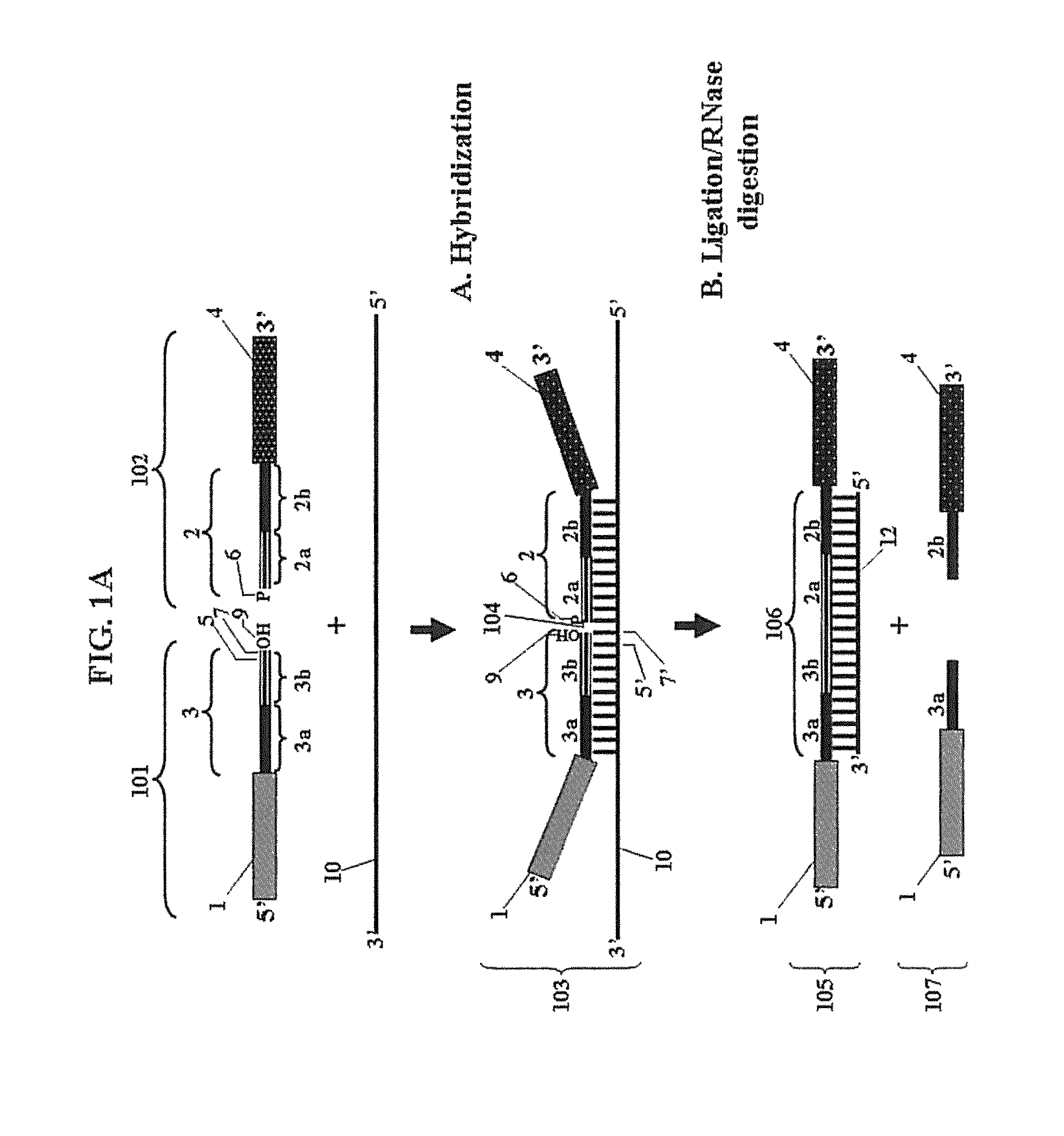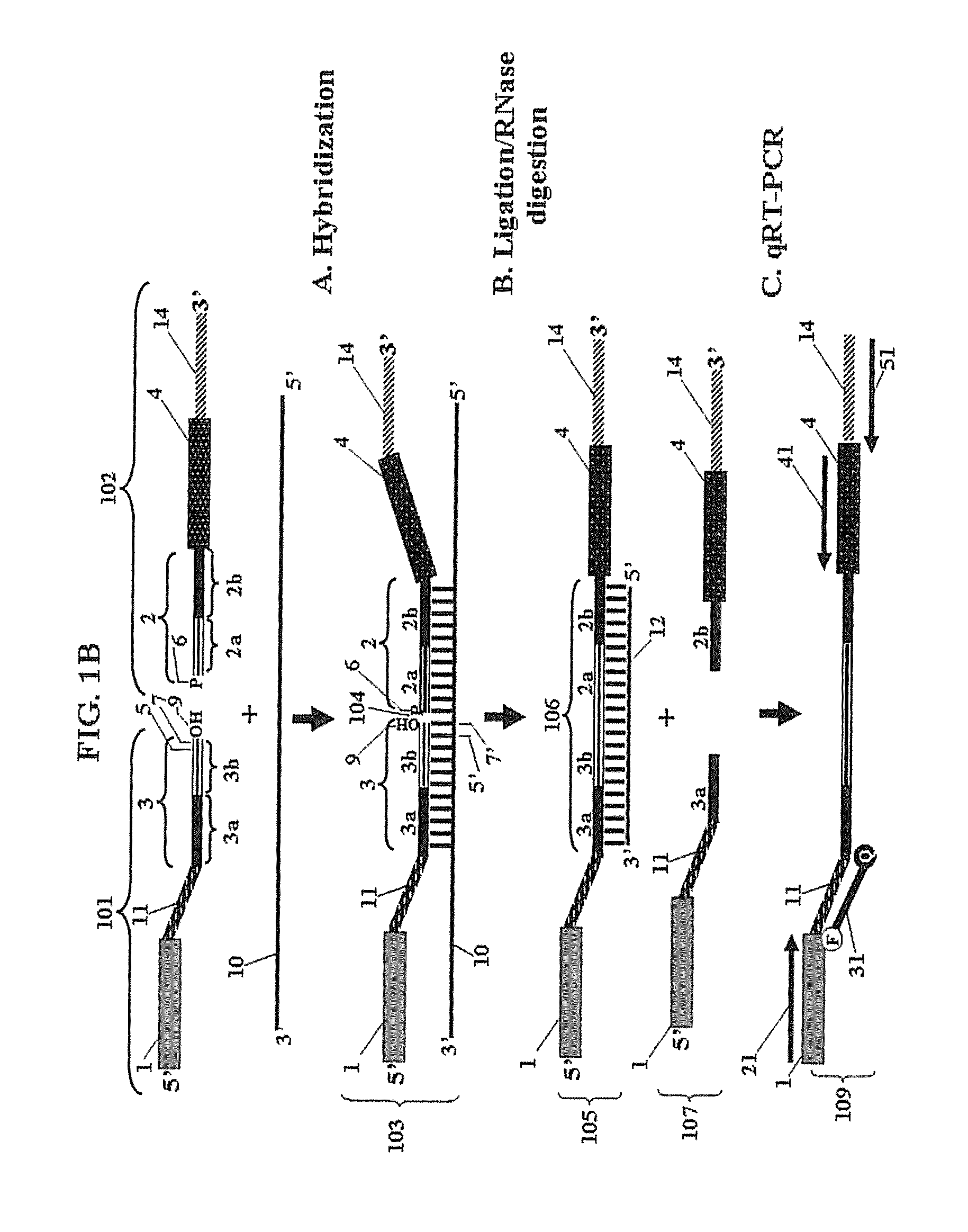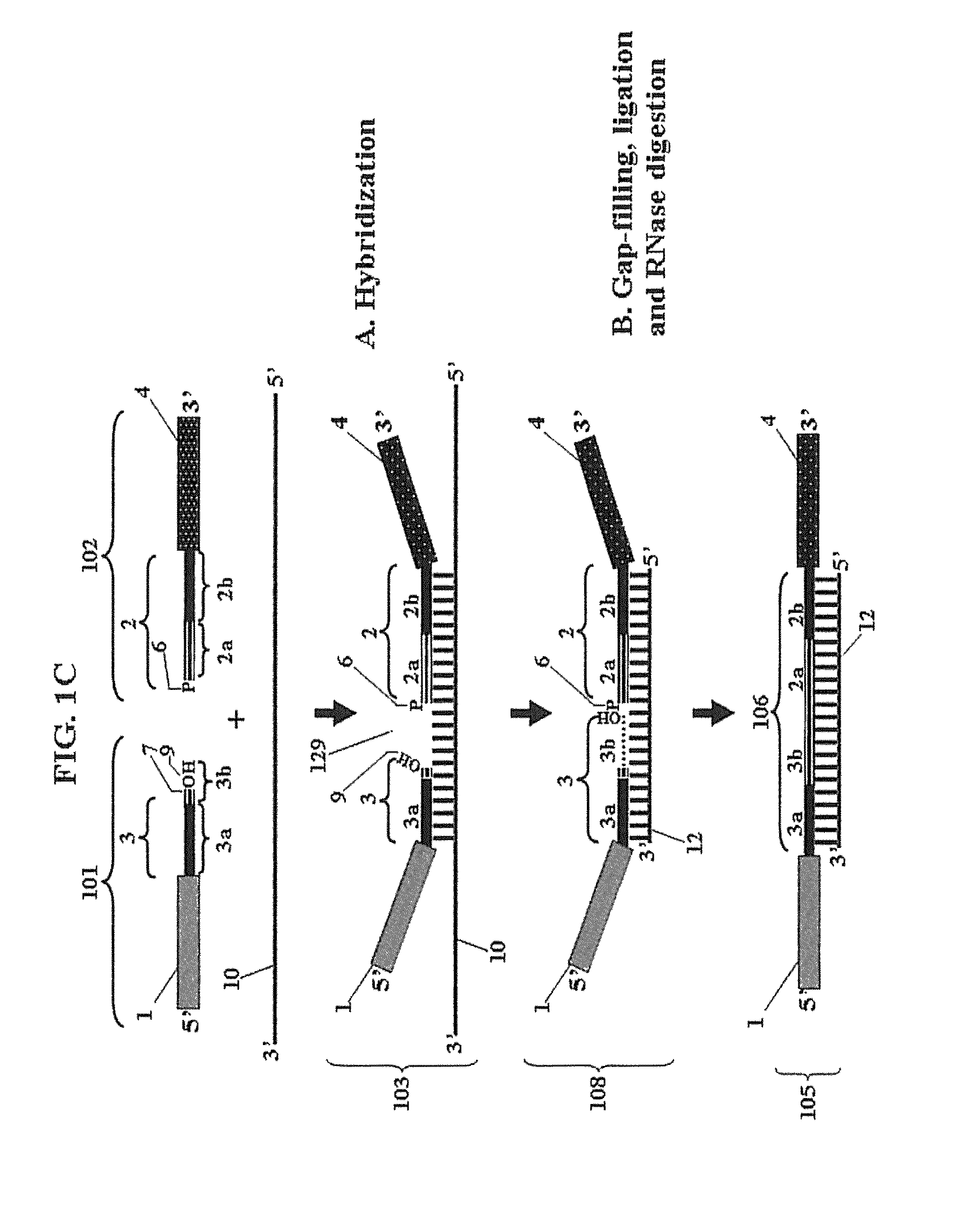Chimeric oligonucleotides for ligation-enhanced nucleic acid detection, methods and compositions therefor
a technology of chimeric oligonucleotides and nucleic acid, applied in the field of compositions, methods, kits for detecting and/or quantifying nucleic acid molecules in samples, can solve the problems of inability to amplify longer products, inability to amplify long products, inability to amplify long products, etc., and achieve the effect of ligation-enhanced nucleic acid detection
- Summary
- Abstract
- Description
- Claims
- Application Information
AI Technical Summary
Benefits of technology
Problems solved by technology
Method used
Image
Examples
example 1
Archived FFPE RNA is Fragmented
[0242]Samples were obtained from 1) frozen kidney tissue, 2) ambient-stored FFPE lung tissue blocks, and 3) ambient-stored FFPE colon tissue blocks. RNA from approximately 10 μm slices of the tissue samples was extracted and purified using the RECOVERALL® kit (Ambion Inc., Austin, Tex.). Total RNA from each sample (about 100 ng to 150 ng) was analyzed on an AGILENT® 2100 bioanalyzer (AGILENT® Technologies, Santa Clara, Calif.) using default parameters. Atypical level of detection for the AGILENT® bioanalyzer is about 0.1 ng / μl.
[0243]An analysis of RNA recovered from frozen kidney tissue is provided by FIG. 6A. An analysis of RNA recovered from ambient-stored FFPE lung tissue blocks and ambient-stored FFPE colon tissue block samples is provided by FIG. 6B and FIG. 6C, respectively. For the figures, the y-axis shows fluorescence intensity in relative units generated by dye binding to RNA, thus peak height is proportional to the amount of RNA. The x-axis ...
example 2
Ligation-enhanced Nucleic Acid Detection Assay Protocol
[0245]The following Table 1 and Table 2 are referred to throughout the following examples.
[0246]
TABLE 1RNA Dilution Buffer80%Deionized formamide300 mMSodium acetate pH 6.4100 mMSodium citrate pH 6.4 1 mMEDTA5%PEG 8000100 ng / mlE. coli RNA2X Hybridization Buffer20%Deionized formamide300 mMSodium acetate pH 6.4100 mMSodium citrate pH 6.4 1 mMEDTA5%PEG 800010x Ligase Buffer500 mMTris pH 7.0100 mMMgCl2100 mMDTT 10 mMATPRNase Cocktail (AMBION ® Inc., Austin, TX #2286)0.5 U / μlRNase A 20 U / μlRNase T110x Complete (SUPERTAQ ™, AMBION ® Inc., Austin, TX) Buffer100 mMTris pH 9.0500 mMKCl 15 mMMgCl2
[0247]
TABLE 21.Total RNA sample is serially diluted with warmed (37° C.) RNA Dilution Buffer to a range of final concentrations (20 ng / μl, 2 ng / μl, 0.2 ng / μl and 0.02 ng / μl); each sample is heated to65° C. for 5 minutes and then placed on ice.2.A set of chimeric oligonucleotide probes are mixed and diluted to 50 fmol / μl (50 nM) each in nuclease-fr...
example 3
Standard qRT-PCR vs. Ligation-Enhanced Nucleic Acid Detection for β-Actin mRNA in Archived Tissue
[0248]RNA from the 2-yr old and 13-yr old FFPE colon tissue samples depicted by FIG. 8A and FIG. 8B was used to compare standard qRT-PCR to ligation-enhanced nucleic acid detection embodiments for limits of detection of the β-actin mRNA target nucleic acid. RNA from approximately 10 μm slices of the tissue blocks was extracted and purified using the RECOVERALL® kit (Ambion Inc., Austin, Tex.). Total RNA from each sample was serially diluted with RNA Dilution Buffer (Table 1).
[0249]This study of standard qRT-PCR versus embodiments of ligation-enhanced nucleic acid detection essentially compares the ability of PCR to amplify the “target region” of a target nucleic acid using primers that have sequence complementarity to sequences that are upstream and downstream of that “target region” with the ability of PCR to amplify the “target region” as represented, by a ligated product and using pri...
PUM
| Property | Measurement | Unit |
|---|---|---|
| time | aaaaa | aaaaa |
| melting temperature | aaaaa | aaaaa |
| temperature | aaaaa | aaaaa |
Abstract
Description
Claims
Application Information
 Login to View More
Login to View More - R&D
- Intellectual Property
- Life Sciences
- Materials
- Tech Scout
- Unparalleled Data Quality
- Higher Quality Content
- 60% Fewer Hallucinations
Browse by: Latest US Patents, China's latest patents, Technical Efficacy Thesaurus, Application Domain, Technology Topic, Popular Technical Reports.
© 2025 PatSnap. All rights reserved.Legal|Privacy policy|Modern Slavery Act Transparency Statement|Sitemap|About US| Contact US: help@patsnap.com



